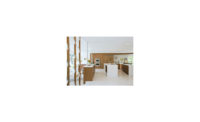Before its conversion into a two-story house, this Los Angeles residence was a rambling 2,400-square-foot ranch of little note. Though it had views of Laurel Canyon, near parkland by Garrett Eckbo, and the neighboring houses were original Midcentury Modern residences—including Pierre Koenig’s Case Study House #21—it lacked the same pedigree and grace. The owners, a couple with three children, decided it was time to reconnect with the area's historic style and its lush views. Specifically, they wanted to feel as if they were living in a modern treehouse.
To achieve that, the project team from Assembledge+, including David Thompson, the principal in charge, built a second level to hold the master suite and replaced walls facing the pool area on the ground floor with as much glass as possible. They employed red cedar and created new proportions to extend the landscape indoors. As the kitchen is central to the plan, all of these strategies help define its space.
Additional Content:
Jump to credits & specifications
To open up the floor plan, the architects demolished a peninsula that had cut off the original 200-square-foot kitchen from the dining room. Two new rectangular islands, set perpendicular to one another, allow foot traffic to flow through the new 300-square-foot kitchen. One island serves as a social gathering point and buffers the activity of the cooking and food-prep areas. The other provides storage and extra counter space.
In the old kitchen, cooking was a centralized experience, with the range set in a run of base cabinets along an interior wall. In the new plan, cooking appliances are strategically spaced throughout the room: the cooktop is located on an island, double ovens are built into one wall, and, on the second, “outer” island, a microwave is installed under the counter at a child-friendly height. The arrangement minimizes congestion at busy mealtimes.
With glass walls overlooking the rear courtyard, architects took steps to keep sight lines open, even specifying an integral downdraft vent for the cooktop to eliminate the need for a ceiling-mounted range hood.
Above the sink, a skylight allows daylight to brighten the work area and contribute to the al fresco ambience of the room.
In the adjoining dining and living areas, operable glass walls complete the physical and visual connection to the outdoors. They slide like a telescope to sit stacked when open to the pool area.
Almost as striking as the combined kitchen/living area’s views are its wood elements. Custom cabinets are built from sustainably harvested oak. Western red cedar planks clad the ceiling—a continuation of the same wood that wraps the exterior of the newly built second floor.
The house’s relationship to the environment isn’t limited to its use of natural materials. On the new roof, the architects installed photovoltaic panels to supplement conventional energy sources; indoors, they added a graywater system that uses recycled water to irrigate the landscape enhancing the residence’s new design.
CreditsArchitect: Assembledge+ — David Thompson, principal; Scott Walter, project architect; Gregory Marin, project manager
Engineer: CM Peck
Interior designer: Alexander Design — Vanessa Alexander, principal
General contractor: Above Board Construction
Clients: Yaniv and Nina Tepper |
SpecificationsGlazing Arcadia Countertops Caesarstone Faucet Dornbracht Sink Franke Appliances Sub-Zero; Wolf Floor tile Porcelanosa Downlights Halo |







Post a comment to this article
Report Abusive Comment